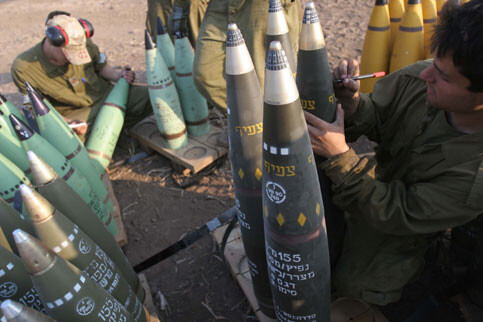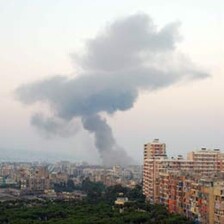Beirut 16 July 2006

Trying to write history: An Israeli soldier writes on a sell at artillery position near the Israeli town Kiryat Shmona, close to the Israeli-occupied Syrian Golan Heights 16 July 16 2006. (MaanImages/Inbal Rose)
This evening as we gathered in Ras Beirut with some close friends for food and conversation, I asked if this war had a name yet. Someone suggested that all of Israel’s wars are known by dates, so this would be the 2006 war. To the Arabs, they are all known as tragedies. This could be the rape of Lebanon (though hardly the deflowering), the July massacre (this only works for the one-month war). If I knew the names of the two captured Israeli soldiers, I might suggest the war be named after them, or has it gone way beyond that?
In a place like Lebanon, it is hard not to dwell on the distant past, which leads me to think about the distant future. How will the history books describe this war? Will there be ultimate victors to place it into some convincing narrative? In “The War in the Air,” H.G. Wells imagined a clash between Asian and European airfleets at Niagara Falls - a clash that spiraled out like a hurricane engulfing the entire world; the “Battle of Niagara” became the graveyard of civilization. A similar Battle of Lebanon is, we all hope, not in the cards. Though I hear the story repeated. Some people seem to feel its centripetal force.
At the Nahr Al-Kalb (Dog River), just north of Beirut, are a series of stelae
carved into the rock where various conquerors left their mark - Rameses II, Nebuchadnezzar II, and sixteen others. They were victors, the writers of history. A little farther north is the Nahr Ibrahim or Adonis River. For millennia, pilgrims journeyed up this stunning valley with its two temples to Astarte (Aphrodite, Venus). At its head, the river pours directly out of the mountain. Pilgrims then hiked over Mount Lebanon (2500 m) to Yamounie where the sacred water poured out the other side of the mountain; adjacent to another temple to Aphrodite (and later shrine to the Blessed Virgin Mary). The pilgrims ended their journey at Baalbeck (Heliopolis) in the Bekaa Valley where eventually the largest temple in the Roman empire was built in honor of Jupiter.
Geologists know that the fault beneath the Great Rift Valley of Africa continues up the Red Sea to Aqaba, then continues beneath the Dead Sea, the Jordan Valley, and finally to Lebanon’s Bekaa. This deep fissure contains the oldest remains of hominid creatures, the lowest point on Earth, the place where Jesus Christ was baptized, and the temples at Baalbek. The Levant is such a small part of the Earth; why do so many people care about a war there that has cost less than 200 lives? Is it because it is potentially the center of a spiral, one not of divine but of human making?
This is a place with too many stories, a surfeit of myth. Most people I talked
to today hoped for the truncated story of a war that ends in days - the
Five-Day War, the Seven-Day War, the Nine-Day War. Lebanon could then resume its difficult (but not hopeless) struggle to bring about a Renaissance. Here is a place that everyone must try to visit once in their lives, not just for its beauty and historical depth, but most of all to encounter these remarkable
people. Stop this war and come.
Related Links
Patrick McGreevy heads up the American Studies Program at the American University of Beirut





